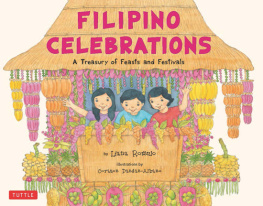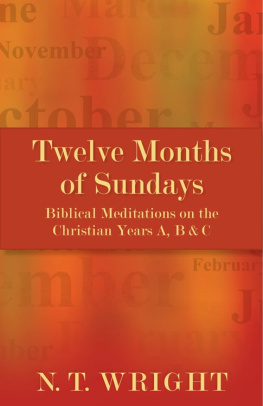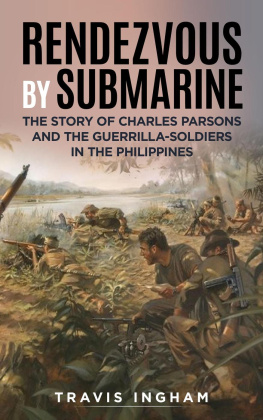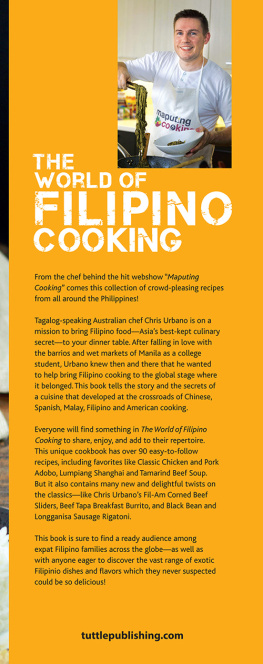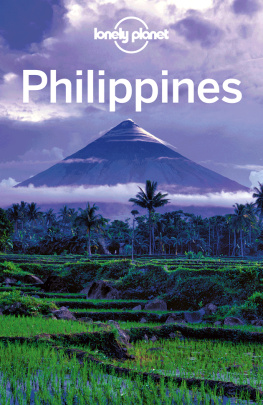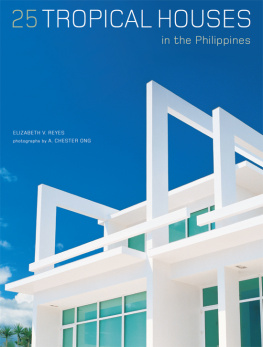Robert Boyer - Sundays in Manila
Here you can read online Robert Boyer - Sundays in Manila full text of the book (entire story) in english for free. Download pdf and epub, get meaning, cover and reviews about this ebook. year: 2013, publisher: University of the Philippines Press and Flipside Publishing, genre: Detective and thriller. Description of the work, (preface) as well as reviews are available. Best literature library LitArk.com created for fans of good reading and offers a wide selection of genres:
Romance novel
Science fiction
Adventure
Detective
Science
History
Home and family
Prose
Art
Politics
Computer
Non-fiction
Religion
Business
Children
Humor
Choose a favorite category and find really read worthwhile books. Enjoy immersion in the world of imagination, feel the emotions of the characters or learn something new for yourself, make an fascinating discovery.
- Book:Sundays in Manila
- Author:
- Publisher:University of the Philippines Press and Flipside Publishing
- Genre:
- Year:2013
- Rating:4 / 5
- Favourites:Add to favourites
- Your mark:
- 80
- 1
- 2
- 3
- 4
- 5
Sundays in Manila: summary, description and annotation
We offer to read an annotation, description, summary or preface (depends on what the author of the book "Sundays in Manila" wrote himself). If you haven't found the necessary information about the book — write in the comments, we will try to find it.
Professor Robert Boyer provides us with a travelers view of the Philippines as he chronicles his travels to the country. Rich with cultural flavor, exotic locales, interesting Filipino practices and traditions, and Boyers steady supply of thoughtful and insightful observations, Sundays in Manila is a fantastic glimpse of history and life in the Philippines.
Sundays in Manila — read online for free the complete book (whole text) full work
Below is the text of the book, divided by pages. System saving the place of the last page read, allows you to conveniently read the book "Sundays in Manila" online for free, without having to search again every time where you left off. Put a bookmark, and you can go to the page where you finished reading at any time.
Font size:
Interval:
Bookmark:
S UNDAYS IN M ANILA

Copyright Robert H. Boyer 2010
First published in print by University of the Philippines Press 2010
Sketches and Cover Design by June Poticar Dalisay
ePub design and production by Flipside team
eISBN 978-971-9922-71-1
This e-book edition published 2011
by University of the Philippines Press
and Flipside Digital Content Company, Inc.
Quezon City, Philippines
www.uppress.com

www.flipsidecontent.com

DEDICATION
To my wife Barb. First, for encouraging me to take advantage of travel opportunities when they arose and joining me on several of these adventures, including my second one in the Philippines for, we thought, an extended period. Secondly, for her inspiring example when she was diagnosed with an advanced stage of breast cancer at the Philippine General Hospital in Manila ten days after joining me in August of 1998. I describe that most hazardous adventure in the chapter entitled Philippine General Hospital. That experience taught us both a great deal about the Philippines and Filipinos, as well as about ourselves and our children.
More than ten years later now (2009), Barb continues to be a survivor and a blessing to us all.
SKETCHES
T O THE R EADER
My object in writing this book is to offer a travelers appreciation of the Philippines and its people from my personal experiences during three separate visits to the country, including teaching in Manila for a semester in 1998. My hope is that the book will be both useful and interesting to American readers, including Filipino Americans, and that it may make worthwhileperhaps divertingreading for Filipinos. My method has been to take notes and pictures and to write from these while the memory is still fresh.
To supplement my own notes and pictures, I have in most cases relied on local Philippine information in its many forms: brochures, maps, atlases, and guidebooks. My reference for checking accuracy of details in preparing the final draft has been The Filipino Saga: History as Social Change by Cortes, Boncan, and Jose. Any inaccuracies that remain are there because I failed to check them in this fine history.
Along with using first-hand experience supplemented by local sources, I have attempted to keep my focus on the people and places rather than dwelling on how they affected me. While my personal reflections inform the writing, I usually keep them in the background, assuming that most readers will be more interested in the subject of the book.
I am enormously grateful to seven people in particular who helped me with this book: Thomas Myers for his encouragement and red pencil; Ciriaco M. Sayson Jr. for his three pages of meticulous notes full of corrections and suggestions; June Poticar Dalisay who saw both the humor and pathos in the book and captured these sentiments in her amazing sketches; Donald Taylor who showed me how to transfer the sketches from paper to electronic medium, then did the job himself; Gerry Los Baos of UP (University of the Philippines) Press for his encouragement along the way; Ria Santos, also of UP Press, for her perceptive final edits; and Heather McCartney Boyer, my agent and daughter, whose guidance has brought the book to fruition.
I wish to thank St. Norbert College for helping to defray the costs of producing this work, twice through grants but also through the wonderful staff people who make the faculty and administration look so good.
Two abbreviations appear frequently in the following pages. RP = The Republic of the Philippines, the official name of the country since 1946. After that date, RP is, for the most part, interchangeable with the Philippines. UP = The University of the Philippines Diliman, Quezon City, Metro Manila. UP Diliman occupies the place of honor and precedence among the six campuses of the public university system and is, therefore, most commonly referred to as just UP. This book follows the common usage. References to the other campuses are written out in full, including the site locations.
P ROLOGUE
T HE F ASCINATION WITH THE P HILIPPINES
This book springs from my life-long fascination with the Philippines as well as my conviction that others will share this fascination to some degree after reading this book. Should you also share my passion for travel, you will find information, observations, and reflections to enhance your journey to the Philippines, especially Manila. If you are not yet planning to visit the Philippines, perhaps these pages will plant the seeds for such plans. Numerous excerpts from this book have already found audiences in Philippine-American weekly or monthly publications in the Midwest and on the West Coast.
My preoccupation with the Philippines arises from a mixture of personal and career reasons. I was a few months over four years old when the US entered World War II. I was six when the news leaked out about the atrocities that had taken place after the fall of Bataan and Corregidor. Those two names, reported on the radio and in the Movietone newsreels that preceded feature films in theaters, took up quiet residence in my impressionable consciousness, to emerge many years later as titles for chapters in this book.
By 1945, at the age of seven, I was playing war games with my older brothers, reenacting the landings at Leyte Gulf and Lingayen Gulf. Generals MacArthur and Wainwright, more than Patton or Eisenhower, were my heroes, and Filipino allies with exotic-sounding names like Romulo, Quezon, Magsaysay, and Macapagal, were their friends. Like Bataan and Corregidor, these names were often on the news on the radio and in the newsreels, and now I was also seeing them as headlines in the newspaper.
My early impressions endured, receiving occasional reinforcement. As a teenager I went to a Christian Brothers high school in Philadelphia where I added to my Philippine lore. From the brothers I learned about De La Salle College (now a university) in Manila, the missions, to which one of my teachers went to serve. A classmate of mine became a Christian Brother, and he too went to teach in the Philippines. In the ensuing years, I retained a personal interest in news from the Philippines, though the coverage of such news in the US wasand isrelatively scant. I read about the Communist insurgency, about the Marcoses, about the Aquinos, and about the nonviolent Peoples Revolution that ousted Ferdinand Marcos.
While I was keeping a casual eye on news from the RP, my professional interests took some turns that would eventually lead me to the Philippines. My research and teaching in the area of medieval European literature brought me to Spain on a sabbatical in 1983. My project was to study the productive interaction among Christians, Jews, and Muslims, called the convivencia, in early medieval Spain, much of which was under Arab rule. A few years later, I got sidetracked into administration, but after this diversion I returned to Spain in 1993 to reconnect with my earlier interests there. I was privileged to spend three and a half months in the medieval center of Spanish Muslim culture, Cordova, the Baghdad of the West in the tenth century. There I studied medieval Spanish literature and history, material that I still plan to transmute into a historical fantasy novel.
An unforeseen outcome of my sojourns in Spain was a compelling interest in Spains global emergence. In 1492 the Spanish Conquistadors completed the centuries-long campaign against the Arabs to reconquer all of Spain. They then expelled all Muslims and Jews, the peoples from whom they and the rest of Europe had learned so much, peoples that had helped to fuel the Renaissance. With their new learning and their unparalleled military prowess, the Spanish now looked for discovery and conquest beyond their own shores. Their extraordinary talents and arrogance brought them to New Spainthe Americasand the Islands of (King) PhilipLas Filipinas, so named in honor of Philip II of Spain around 1543.
Next pageFont size:
Interval:
Bookmark:
Similar books «Sundays in Manila»
Look at similar books to Sundays in Manila. We have selected literature similar in name and meaning in the hope of providing readers with more options to find new, interesting, not yet read works.
Discussion, reviews of the book Sundays in Manila and just readers' own opinions. Leave your comments, write what you think about the work, its meaning or the main characters. Specify what exactly you liked and what you didn't like, and why you think so.


